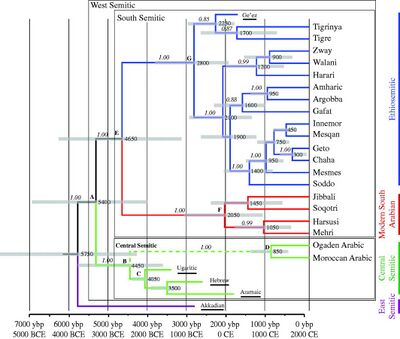Social:Ethiopian Semitic languages
| Ethiopian Semitic | |
|---|---|
| Ethiopic, Ethiosemitic, Abyssinian | |
| Geographic distribution | Ethiopia, Eritrea, Sudan[1] |
| Linguistic classification | Afro-Asiatic
|
| Subdivisions |
|
| Glottolog | ethi1244[2] |
Ethiopian Semitic (also Ethio-Semitic, Ethiosemitic, Ethiopic or Abyssinian[3]) is a family of languages spoken in Ethiopia, Eritrea, and Sudan.[4] They form the western branch of the South Semitic languages, itself a sub-branch of Semitic, part of the Afroasiatic language family.
With 57,500,000 total speakers as of 2019, including around 25,100,000 second language speakers, Amharic is the most widely spoken language of Ethiopia and second-most commonly spoken Semitic language in the world (after Arabic).[5][6] Tigrinya has 7 million speakers and is the most widely spoken language in Eritrea.[7][8] There is a small population of Tigre speakers in Sudan, and it is the second-most spoken language in Eritrea. The Ge'ez language has a literary history in its own Ge'ez script going back to the first century AD. It is no longer spoken but remains the liturgical language of the Ethiopian and Eritrean Orthodox Tewahedo Churches, as well as their respective Eastern Catholic counterparts.
The "homeland" of the South Semitic languages is widely debated, with some sources, such as A. Murtonen (1967) and Lionel Bender (1997),[9] suggesting an origin in Ethiopia, and others suggesting the southern portion of the Arabian Peninsula.[10] A study based on a Bayesian model suggested the latter.[11] This statistical analysis could not estimate when or where the ancestor of all Semitic languages diverged from Afroasiatic but it suggested that the divergence of East, Central, and South Semitic branches occurred in the Levant.[12] According to many scholars, Semitic originated from an offshoot of a still earlier language in North Africa, perhaps in the southeastern Sahara, and desertification forced its inhabitants to migrate in the fourth millennium BC – some southeast into what is now Ethiopia, others northeast out of Africa into Canaan, Syria and the Mesopotamian valley.[13]
The modern Ethiopian Semitic languages all share subject–object–verb (SOV) word order as part of the Ethiopian language area, but Ge'ez had verb-subject-object (VSO) order in common with other Semitic languages spoken in what is now Yemen.
Classification
The division of Ethiopic into northern and southern branches was proposed by Cohen (1931) and Hetzron (1972) and garnered broad acceptance, but has been challenged by Rainer Voigt, who concludes that the northern and southern languages are closely related.[14]
- Ethiopic
- North Ethiopic
- South Ethiopic
- Transversal South Ethiopic
- Outer South Ethiopic
Hudson (2013)
Hudson (2013) recognises five primary branches of Ethiosemitic. His classification is below.[18]
References
- ↑ https://www.ethnologue.com/25/country/SD/
- ↑ Hammarström, Harald; Forkel, Robert; Haspelmath, Martin, eds (2017). "Ethiosemitic". Glottolog 3.0. Jena, Germany: Max Planck Institute for the Science of Human History. http://glottolog.org/resource/languoid/id/ethi1244.
- ↑ Diakonov, Igor Mikhailovich (1965). Semito-Hamitic Languages: An Essay in Classification. Nauka: Central Department of Oriental Literature. pp. 12. https://books.google.com/books?id=hHoOAAAAYAAJ&q=%22Abyssinian+languages%22.
- ↑ https://www.ethnologue.com/25/country/SD/
- ↑ "Amharic". Ethnologue. https://www.ethnologue.com/language/amh/25.
- ↑ "The world factbook". 18 September 2023. https://www.cia.gov/the-world-factbook/countries/ethiopia/.
- ↑ Woldemikael, Tekle M. (April 2003). "Language, Education, and Public Policy in Eritrea". African Studies Review 46 (1): 117–136. doi:10.2307/1514983.
- ↑ Simeone-Senelle, Marie-Claude (December 2005). "Up todate Assessment of the results of the research on the Dahalik language (December 1996 - December 2005)". http://llacan.vjf.cnrs.fr/PDF/Publications/Senelle/DahlikBilan.pdf.
- ↑ Bender, L. (1997). "Upside Down Afrasian". Afrikanistische Arbeitspapiere 50: 19–34.
- ↑ Hetzron, Robert (1972) (in EN). Ethiopian Semitic: Studies in Classification. Manchester University Press. pp. 122. ISBN 9780719011238.
- ↑ Kitchen, Andrew; Ehret, Christopher; Assefa, Shiferaw; Mulligan, Connie J. (29 April 2009). "Bayesian phylogenetic analysis of Semitic languages identifies an Early Bronze Age origin of Semitic in the Near East". Proceedings of the Royal Society B: Biological Sciences 276 (1665): 2703–2710. doi:10.1098/rspb.2009.0408. PMID 19403539.
- ↑ Kitchen, A.; Ehret, C.; Assefa, S.; Mulligan, C. J. (29 April 2009). "Bayesian phylogenetic analysis of Semitic languages identifies an Early Bronze Age origin of Semitic in the Near East". Proceedings of the Royal Society B: Biological Sciences 276 (1668): 2703–10. doi:10.1098/rspb.2009.0408. PMID 19403539.
- ↑ Weitzman, Steven (2017). The Origin of the Jews: The Quest for Roots in a Rootless Age. Princeton: Princeton University Press. p. 69. ISBN 978-0-691-19165-2. https://books.google.com/books?id=c3SYDwAAQBAJ&dq=The+Origin+of+the+Jews:+The+Quest+for+Roots+in+a+Rootless+Age&pg=PA69. Retrieved 11 January 2023.
- ↑ Voigt, Rainer. "North vs. South Ethiopian Semitic". http://portal.svt.ntnu.no/sites/ices16/Proceedings/Volume%204/Rainer%20Voigt%20-%20North%20vs.%20South%20Ethiopian%20Semitic.pdf. Via Scribd
- ↑ For its membership in North Ethiopic, see Leslau, Wolf (1970). "Ethiopic and South Arabian". Linguistics in South West Asia and North Africa. The Hague. pp. 467., and Faber, Alice (2005). "Genetic Subgrouping of the Semitic Languages". The Semitic Languages. Routledge. pp. 6–7..
- ↑ "Ethiopia to Add 4 More Official Languages to Foster Unity". Ventures. 4 March 2020. http://venturesafrica.com/ethiopia-to-add-4-more-official-languages-to-foster-unity/.
- ↑ "Constitution of the Federal Democratic Republic of Ethiopia – Article 5". Federal Government of Ethiopia. http://www.wipo.int/edocs/lexdocs/laws/en/et/et007en.pdf.
- ↑ Hudson, Grover (2013). Northeast African Semitic: Lexical Comparisons and Analysis. Wiesbaden: Harrassowitz. p. 289.
Bibliography
- Cohen, Marcel (1931) (in fr). Études d'éthiopien méridional. Paris.
- Hetzron, Robert (1972). Ethiopian Semitic: studies in classification. Manchester: Manchester University Press.
- Weninger, Stefan. "Vom Altäthiopischen zu den neuäthiopischen Sprachen". in Haspelmath, Martin; König, Ekkehard; Oesterreicher, Wulf et al. (in de). Language Typology and Language Universals. 2. Berlin: Walter de Gruyter. pp. 1762–1774.
 |


